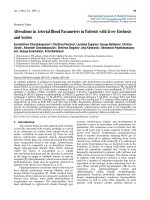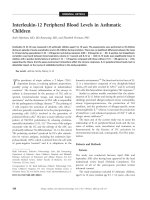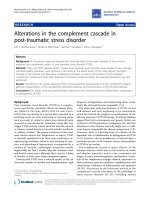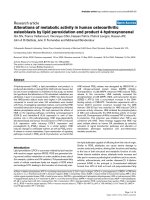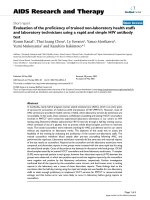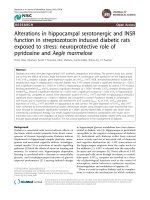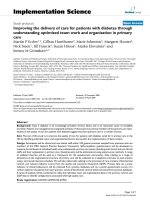Báo cáo y học: "Alterations in Arterial Blood Parameters in Patients with Liver Cirrhosis and Ascite" docx
Bạn đang xem bản rút gọn của tài liệu. Xem và tải ngay bản đầy đủ của tài liệu tại đây (94.92 KB, 4 trang )
Int. J. Med. Sci. 2007, 4
94
International Journal of Medical Sciences
ISSN 1449-1907 www.medsci.org 2007 4(2):94-97
© Ivyspring International Publisher. All rights reserved
Research Paper
Alterations in Arterial Blood Parameters in Patients with Liver Cirrhosis
and Ascites
Konstantinos Charalabopoulos
1,2
, Dimitrios Peschos
3
, Leonidas Zoganas
4
, George Bablekos
4
, Christos
Golias
1
, Alexander Charalabopoulos
1
, Dimitrios Stagikas
1
, Angi Karakosta
1
, Athanasios Papathanasopou-
los
5
, George Karachalios
2
, Anna Batistatou
3
1. Department of Physiology, Clinical Unit, Medical Faculty, University of Ioannina, Ioannina, Greece.
2. Department of Medicine, Red Cross Hospital, Athens, Greece.
3. Department of Pathology, Medical Faculty, University of Ioannina, Ioannina, Greece.
4. Department of Thoracic Surgery, Red Cross Hospital, Athens, Greece.
5. Department of Medicine, Gastroenterology Unit, Medical Faculty, University of Ioannina, Ioannina, Greece.
Correspondence to: Associate Professor K.A. Charalabopoulos, MD, PhD., Department of Physiology, Clinical Unit, Medical Faculty,
University of Ioannina, 13, Solomou str. 452 21 Ioannina, Greece. Tel: 003 26510 97574 Fax: 003 26510 97850 e-mail:
Received: 2006.09.08; Accepted: 2007.03.01; Published: 2007.03.06
In cirrhotic patients, in addition to hepatocytes and Kuppfer cells dysfunction circulatory anatomic shunt and
ventilation/perfusion (V
A
/ Q) ratio abnormalities can induce decrease in partial pressure of oxygen in arterial
blood (PaO
2
), in oxygen saturation of hemoglobin (SaO
2
) as well as various acid-base disturbances. We studied 49
cases of liver cirrhosis (LC) with ascites compared to 50 normal controls. Causes were: posthepatic 37 (75.51%),
alcoholic 7 (14.24%), cardiac 2 (4.08%), and cryptogenic 3 (6.12%). Complications were: upper gastrointestinal
bleeding 24 (48.97), hepatic encephalopathy 20 (40.81%), gastritis 28 (57.14%), hepatoma 5 (10.2%), renal hepatic
syndrome 2 (4.01%), HbsAg (+) 24 (48.97%), and hepatic pleural effusions 7 (14.28%). Average PaO
2
and SaO
2
were 75.2 mmHg and 94.5 mmHg, respectively, compared to 94.2 mmHg and 97.1 mmHg of the control group,
respectively (p value in both PaO
2
and SaO
2
was p<0.01). Respiratory alkalosis, metabolic alkalosis, metabolic
acidosis, respiratory acidosis and metabolic acidosis with respiratory alkalosis were acid-base disturbances ob-
served. In conclusion, portopulmonary shunt, intrapulmonary arteriovenous shunt and V
A
/Q inequality can
induce a decrease in PaO
2
and SaO
2
as well as various acid-base disturbances. As a result, pulmonary resistance is
impaired and patients more likely succumb to infections and adult respiratory distress syndrome.
Key words: liver cirrhosis, ascites, acid base disturbances, hepatopulmonary syndrome
1. Introduction
The arterial blood of some patients with cirrhosis
is not fully saturated with oxygen, probably as a result
of an admixture of venous with arterial blood and
under- ventilation of some alveoli [1]. There are well
known right-to-left anatomic shunts demonstrable
between vessels that carry venous blood and those that
carry oxygenated blood in the lungs. Arteriovenous
shunt may be congenital e.g. in hereditary hemor-
rhagic teleangiectasia (Rendu Osler Weber disease)
where the lesion is transmitted as a simple
non-sex-linked dominant and the disorder is observed
in the lungs as single or multiple lesions, or may be
acquired [2]. Intrapulmonary arteriovenous shunt and
portopulmonary shunt may be acquirely observed in
patients with chronic liver disease [3, 4, 5, 6].
Hepatopulmonary syndrome refers to the triad of
liver disease, pulmonary vascular dilation, and re-
duced arterial oxygenation [7]. While marked mani-
festations of the syndrome are unusual in patients with
chronic liver disease, more subtle abnormalities of
oxygenation are common. The abnormalities have
been attributed to right-to-left shunts through pul-
monary arteriovenous fistulas and development of
bronchial varices in association with pulmonary hy-
pertension. The syndrome occurs in chronic liver dis-
ease of all types and is more common in those with
severe liver disease. Furthermore, portopulmonary
shunt is another mechanism inducing blood gas al-
terations observed in patients suffering from severe
chronic liver cirrhosis with ascites [8]. It is well known
that portal hypertension has an important role in the
formation of ascites by raising hydrostatic pressure
within the splanchnic capillary bed. Ascites is most
frequently encountered in patients with cirrhosis and
other forms of severe liver disease. The clinical course
of patients with advanced cirrhosis is often compli-
cated by a number of important sequelae that are in-
dependent of the etiology of the underlying liver dis-
ease. These include portal hypertension with its con-
sequences (e.g. gastroesophageal varices and
splenomegaly), ascites, hepatic encephalopathy,
spontaneous bacterial peritonitis, hepatorenal syn-
drome, hepatopulmonary syndrome, hepatocellular
carcinoma as well as some other sequelae. In some
patients with massive ascites, pleural effusion is
Int. J. Med. Sci. 2007, 4
95
common but even without it, pulmonary collapse and
atelectasis may lead to arterial undersaturation since
some alveoli are underventilated or not ventilated at
all.
As a result of all those above described abnor-
malities the prognosis is poor on the basis of both the
pulmonary and hepatic disease in patients with severe
liver cirrhosis and ascites.
2. Methodology
Forty-nine (49) patients without any cardiopul-
monary disease with liver cirrhosis and ascites (35
males, 14 females, ratio 2.5:1 and average mean age 65
years with age range 42-81 years) were enrolled in the
study. A group of fifty (50) healthy individuals con-
sisted the control group. Cirrhosis had been diagnosed
by history, clinical examination, laboratory findings,
and liver biopsy, which all patients underwent. From a
clinical point of view the patients’ conditions varied
from moderate to severe according to the Child-Pugh
classification (B, C class). None of the patients com-
plained of dyspnea. Patients with parenchymal lung
disease were excluded from the study. Furthermore,
none of them presented diagnostic criteria for asthma,
chronic bronchitis, or emphysema according to the
American Thoracic Society Directions.
Since classification of the various types of cirrho-
sis based on either etiology or morphology alone is
unsatisfactory, we usefully classified the studied pa-
tients by a mixture of etiologically and morphologi-
cally defined entities based on clinical, pathological,
and other data as follows: posthepatic 37 cases
(75.51%), alcoholic 7 cases (14.24%), cardiac 2 cases
(4.08%), and cryptogenic 3 cases (6.12%). The term
posthepatic, synonymously to postnecrotic or multi-
lobular cirrhosis, has been used in cases of cirrhosis
resultant to viral hepatitis or infectious diseases,
autoimmune hepatitis, inherited and metabolic disor-
ders, as well as to drugs and toxins. In particular,
based on epidemiologic and serologic evidence
(HBsAg, HBeAg, anti-HbC, HBV-DNA) the vast ma-
jority of posthepatic cases was due to viral hepatitis (35
cases, 94.59%), due mostly to type B (26 cases, 74.28%),
or type C (7cases, 20%), and concomitant presence in 2
cases (5.71%). Similarly, the term cryptogenic cirrhosis
has been used in cases in which the etiology of the
cirrhosis was unknown.
Complications observed in the patients studied
were: upper gastrointestinal (UGI) bleeding in 20 cases
(48.97%), hepatic encephalopathy 20 cases (40.81%),
gastritis 28 cases (57.14%), hepatoma 5 cases (10.2%),
hepatorenal syndrome 2 cases (4.01%), HbsAg (+) 24
cases (48.97%), and hepatic pleural effusions 7 cases
(14.28%). Table 1 and table 2 summarize patients clas-
sification and complications observed.
Partial pressure of oxygen in arterial blood (PaO
2
),
oxygen saturation of hemoglobin (SaO2) as well as
various acid-base disturbances were determined in all
patients and normal controls as well. Arterial blood
samples were taken while patients were breathing
room air (FiO
2
: 21%) in a half seated position. They
underwent a puncture from the radical artery. PaO
2
was immediately measured as well as carbon dioxide
tension (PaCO
2
) and oxyhemoglobin saturation (SaO
2
).
Table 1. Classification of patients of the study.
Etiology of the disease Nr %
posthepatic 37 75.51
alcoholic 7 14.24
cardiac 2 4.08
cryptogenic 3 6.12
Total 49 100
Table 2. Complications of the cirrhotic patients under study.
Nr
%
UGI bleeding 24 48.97
Hepatic encephalopathy 20 40.81
Gastritis 28 57.14
Hepatoma 5 10.2
Hepatorenal syndrome 2 4.01
Hbs Ag + 24 48.97
Hepatic pleural effusion 7 14.28
Accompanied acid base disturbances
Respiratory alkalosis 22 44.89
Metabolic alkalosis 7 14.28
Metabolic acidosis 3 6.12
Respiratory acidosis 3 6.12
Metabolic acidosis + respiratory alkalosis 4 8.16
Normal acid base balance 10 20.4
3. Results
A PaO
2
of equal or less than 80mmHg was de-
fined as hypoxemia values. Values taken from the pa-
tients group were as low as below 80 mm Hg with an
average PaO
2
of 75.2 mm Hg while that in fifty healthy
controls was 94.2 mm Hg.
Statistically, a significant difference was found
(p<0.01) between those compared groups. SaO
2
values
were in average 94.5 mm Hg and 97.1 mm Hg, respec-
tively, showing also a statistically significant difference
(p<0.01). Furthermore, a weak relationship between
PaO
2
and Pugh score was found in the patients group.
Mean arterial PaCO
2
in the patients group was 33.9±1.5
mmHg with hypocapnia most frequently found.
Acid-base disturbances observed were: respira-
tory alkalosis in 22 cases (44.89 %), metabolic alkalosis
in 7 (14.28 %), metabolic acidosis in 3 (6.12 %), respi-
ratory acidosis in 3 (6.12 %), and metabolic acidosis
with respiratory alkalosis in 4 (8.16 %). Normal acid
base balance was observed in 10 (20.40 %). Breath rate
frequency in all patients studied, was within the nor-
mal rates; thus, acid-base disturbances could not be
attributed solely to breath frequency abnormalities (e.g.
respiratory alkalosis in patients with tachypnea).
Tables 1 and 2 show the classification of patients
regarding the etiology of their disease as well as com-
plications and acid based disturbances observed. None
of the complications observed was attributed to drugs
administered.
4. Discussion
Mild hypoxemia occurs in approximately
one-third of patients with chronic liver disease. Arte-
Int. J. Med. Sci. 2007, 4
96
rial venous anastomoses and communications between
the portal and arterial circulation as well as between
bronchial and pulmonary veins are more likely to be
functional in patients with cirrhosis and account for
hypoxemia, as well as for perfusion defects seen on
lung scan in patients with cirrhosis [9].
Shunts observed in patients with severe liver
disease resulting in blood gas alterations may be con-
tributed to portopulmonary shunt due to the portal
hypertension development as well as to intrapulmon-
ary arteriovenous shunt and V
A
/Q inequality. Hepa-
topulmonary syndrome, an infrequent complication of
chronic liver disease usually associated with portal
hypertension and cirrhosis, is manifested by dyspnea,
platypnea and orthopnea and nowadays is more
widely diagnosed occurring in chronic liver disease of
all types and mainly in severe suffering patients [4, 9,
10, 11].
Liver cirrhosis is often accompanied by arterial
hypoxemia in the absence of cardiopulmonary disease
but the natural history of this syndrome is unknown.
This fact was initially thought to be associated with the
severity of the liver disease [12]. None of the patients
enrolled in our study presented dyspnea and/or
chronic lung disease according to the American Tho-
racic Society Directions. However, spirometric tests
performed in all patients studied, confirmed the issue
under discussion. Although putative mechanisms of
hypoxemia include an intra- or extrapulmonary shunt,
ventilation – perfusion inequality, and alveolar capil-
lary diffusion limitation, there is a lack of agreement
on which factors are the most important [13]. To the
majority of cirrhotic patients that present dyspnea, this
appears to be a consequence of ascites, hepatic hydro-
thorax or cardiopulmonary diseases. A wide spectrum
of pulmonary gas exchange abnormalities may be
found in patients with advanced liver disease [14]. The
most frequent alteration of gas exchange in cirrhosis is
hypocapnia observed in approximately 73% of cir-
rhotic patients which is associated with pulmonary
vasodilatation. We hypothesize that hypocania, in as-
sociation with vasodilating substances such as nitric
oxide (NO) and endothelins, may contribute- at least in
part- in the induction of hypoxemia. Pulmonary vaso-
dilatation is even more frequent and severe in patients
with advanced hepatocellular dysfunction. Intrapul-
monary vasodilatation found in cirrhosis is thought to
be at least partly involved in the development of hy-
poxemia, though some studies are arguing whether or
not hypoxemia develops in patients with intrapul-
monary vasodilatation [15, 16]. In our study all of pa-
tients with cirrhosis (Child-Pugh B and C) had hy-
poxemia.
Contradictory, according to another study, the
factor mostly inducing hypoxemia in liver cirrhosis is
not the disease severity or the abnormal pulmonary
circulation but rather the alcoholic etiology of cirrhosis
[16]. Furthermore, according to similar studies the
smoking status frequently coexisting in alcoholics had
no significant effect on pulmonary functions in pa-
tients with liver diseases [16, 17]. Hypoxemia observed
in alcoholic cirrhosis does not seem to be caused by
alcohol induced disorders in the extrahepatic organs. It
seems rather to be associated with an accelerated hy-
perdynamic and hypermetabolic circulatory state that
favors hypoxemia [18, 19]. All patients with alcoholic
cirrhosis studied, herein, (7 out of 49, 14.24%) were in a
hypoxemic state. Several studies support this assump-
tion suggesting that an increased oxygen demand due
to excess alcohol consumption is the primary cause of
hypoxemia in alcoholic patients [19]. Moreover, in
these series of patients none presented with dyspnea
or clinical signs of hepatopulmonary syndrome. These
findings confirm previous clinical investigations that
illustrated hypoxemia is a common finding in patients
with cirrhosis particularly in those with Child-Pugh
grade C, (grade < 14), in whom, furthermore, clinical
manifestations were rare [20-23]. According to previ-
ously published studies, concerning patients with liver
cirrhosis, the incidence of hypoxemia appeared to be
high in Child-Pugh grade C, presenting a slight dif-
ference with those patients classified as grade A or B
[12, 23]. Results of the present study coincide with
these reports published earlier. The weak link between
PaO
2
and Pugh score found herein, suggests that other
mechanisms apart from PaO
2
, are involved in the cir-
rhosis associated hypoxemia mechanisms.
Chronic liver disease, arterial deoxygenation and
widespread intrapulmonary vasodilatation character-
ize the hepatopulmonary syndrome [22]. In decom-
pensate cirrhotic patients, there is an increased arte-
riovenous shunt for oxygen in the lower extremities
that is associated with increased arterial blood flow,
decreased systemic vascular resistance and worsening
of the liver function. This shunt is due at least partly to
the opening of arteriovenous precapillary connections
[24]. No any treatment is clinically useful, thus, at
present the only treatment resulting to the resolution
of the syndrome with simultaneous correction of the
blood gas oxygenation alterations is the orthotopic
liver transplantation.
Fluid in the chest (pleurisity) may be found in at
least 10 percent of patients with cirrhosis, being more
common on the right side influencing when in large
quantities the V
A
/Q ratio. In the present study 7 pa-
tients (14.28%) presented pleurisity. Hypoxemia usu-
ally appears to be worse in standing than in supine
position. Oxygen administration improves dyspnea
but does not reverse the defects in some patients [25].
Embolization of shunts if it is possible may be useful.
Gastrointestinal hemorrhage, in the type of
variceal bleeding represents a common complication
of chronic liver disease and is associated with a high
mortality. Studies carried out in a cirrhotic rat model
suggested that blood volume restitution following
hemorrhage, produce an increase in portal pressure
above the limit of the basal values in animals with high
portal systemic shunting [26]. Additionally, a number
of studies have shown that patients with alcoholic liver
disease are known to have a variable and occasionally
extensive degree of portosystemic shunting ranging
from 5-70% [25, 26]. It must be mentioned that all pa-
Int. J. Med. Sci. 2007, 4
97
tients’ medicines were always administrated with
caution, especially those eliminated or modified
through hepatic metabolism or biliary pathways. In
particular, care was taken in order to avoid precipi-
tating complications of cirrhosis due to overzealous
use of drugs such as vigorous treatment of ascites with
diuretics that might result in electrolyte abnormalities
or hypovolemia. Similarly, sedatives even in modest
doses were not used in the patients; so that encepha-
lopathy observed in some patients studied herein,
could not be attributed to such a use.
5. Conclusions
In conclusion, in patients suffering from severe
liver cirrhosis and ascites, portopulmonary shunt, in-
trapulmonary shunt and V
A
/Q inequality may induce
a decrease in PaO
2
and SaO
2
in association with vari-
ous acid-base disturbances. As a result, pulmonary
resistance is impaired and patients more likely suc-
cumb to infections and adult respiratory distress syn-
drome. Thus, prognosis in those patients is poor on the
basis of both hepatic and pulmonary disease.
Conflict of interest
The authors have declared that no conflict of in-
terest exists.
References
1. Aller R, Moya J, Moreira V, Boixeda D, Picher J, Garcia-Rull S,
De Luis D. Etiology and frequency of gas exchange abnormali-
ties in cirrhosis. Rev Esp Enterm Dig. 1999; 91: 559-568.
2. Dines D, Arms RA, Bernatz Re. Pulmonary arteriovenous fistu-
las. Mayo Clinic Proc. 1975; 49: 460-471.
3. Vlavianos P, Mac Mathuna P, Williams R, Westaby D. Splanch-
nic and systemic haemodynamic response to volume changes in
patients with cirrhosis and portal hypertension. Clin Sci (Colch).
1999; 96: 475-481.
4. Denie C, Vachiery F, Gadano A, Sogni P, Elman A, Moreau R,
Valla D, Lebrec D. Influence of transjugular intrahepatic porto-
systemic shunts (TIPS) on tissue oxygenation in patients with
cirrhosis. Liver 1998; 18: 239-244.
5. Duranti R, Laffi G, Misuri G, Riccardi D, Gorini M, Foschi M,
Iandelli I, Mazzanti R, Mancini M, Scano G, Gentilini P.
Respiratory mechanics in patients with tense cirrhotic ascites.
Eur Respir J. 1997; 10: 1622-1630.
6. Fernandez-Rodriguez CM, Prieto J, Zozaya JM, Quiroga J,
Guitian R. Arteriovenous shunting, hemodynamic changes, and
renal sodium retention in liver cirrhosis. Gastroenterology 1993;
104: 1139-1145.
7. De BK, Sen S, Biswas PK, Biswas J, Maity AK. Clinical and
haemodynamic aspects of hepatopulmonary syndrome in In-
dian patients with cirrhosis. J Gastroenterol Hepatol. 2000; 15:
412-416.
8. Nagral A, Kolhatkar VP, Bhatia SJ, Taskar VS, Abraham P.
Pulmonary function tests in cirrhotic and non-cirrhotic portal
hypertension. Indian J Gastroenterol. 1993; 12: 36-40.
9. Stanley N, Ackrill B, Wood J. Lung perfusion scanning in he-
patic cirrhosis. Br Med J. 1972; 4: 639-643.
10. Muller C, Shen KP. Hepatopulmonary syndrome. Wien Klin
Wochenschr. 1999; 111: 339-347.
11. Martinez G, Barbera JA, Navasa M. Hepatopulmonary syn-
drome associated with cardiorespiratory disease. J Hepatol.
1999; 30: 882-889.
12. Vachiery F, Moreau R, Hadengue A, Gadano A, Soupison T,
Valla D, Lebrec D. Hypoxemia in patients with cirrhosis: rela-
tionship with liver failure and hemodynamic alterations. J
Hepatol. 1997; 27: 492-495.
13. Krowka MJ. Pulmonary aspects of chronic liver disease and liver
transplantation. Mayo Clinic Proc. 1985; 60: 407-418.
14. Martinez GP, Barbera JA, Visa J, Rimola A, Pare JC, Roca J, Na-
vasa M, Rodes J, Rodriguez-Roisin R. Hepatopulmonary syn-
drome in candidates for liver transplantation. J Hepatol. 2001;
34: 651-657.
15. Abrams GA, Jaffe CC, Hoffer PB, Binder HJ, Fallon MB. Diag-
nostic utility of contrast echocardiography and lung perfusion
scan patients with hepatopulmonary syndrome. Gastroenterol-
ogy 1995; 109: 1283-1288.
16. Shingeo M, Chisato H, Nobuyuki O, Yoshiro K, Kensuke U,
Atsushi S, Kazuhiro K, Katsuhiko F, Hirashi K, Yasufumi O.
Prevalence of hypoxemia in 102 Japanese patients with alcoholic
and nonalcoholic cirrhosis. Am J Gastroenterol. 1999; 94:
2994-2999.
17. Hourani JM, Bellamy PE, Tashkin DP, Batra P, Simmons MS.
Pulmonary dysfunction in advanced liver disease: Frequent oc-
currence of an abnormal diffusing capacity. Am J Med. 1991; 90:
693-700.
18. Luca A, Garcia-Pagan JC, Bosch J, Feu F, Caballeria J, Grosz-
mann RJ, Rodes J. Effects of ethanol consumption on hepatic
hemodynamics in patients with alcoholic cirrhosis. Gastroen-
terology 1997; 112: 1284-1289.
19. Silva G, Fluxa F, Bresky G, Backhouse C, Palma M, Ruiz M,
Hirsch S, Iturriaga H. Splanchnic and systemic hemodynamics
in early abstinence and after ethanol administration in
non-cirrhotic alcoholic patients. J Hepatol.1994; 20: 494-499.
20. Fallon MB, Abrams GA. Pulmonary dysfunction in chronic liver
disease. Hepatology 2000; 32: 859-865.
21. Krowka M. Hepatopulmonary syndromes. Gut 2000; 46: 1-4.
22. Schenk P, Schoniger-Hekele M, Fuhrmann V, Madl C, Silber-
humer G, Muller C. Prognostic significance of the hepatopul-
monary syndrome in patients with cirrhosis. Gastroenterology
2003; 125: 1042-1052.
23. Herve P, Lebrec D, Brenot F, Simonneau G, Humbert M, Sitbon
O, Duroux P. Pulmonary vascular disorders in portal hyperten-
sion. Eur Respir J 1998; 11: 1153-1166.
24. Fernandez-Rodriguez CM, Prieto J, Zozaya JM, Quiroga J, Gui-
tan R. Arteriovenous shunting, hemodynamic changes, and re-
nal sodium retention in liver cirrhosis. Gastroenterology. 1993;
104: 1139-1145.
25. Sakurabayashi S, Sezai S, Yamamoto Y, Hirano M, Oka H. Em-
bolisation of portal-systemic shunts in cirrhotic patients with
chronic reccurent hepatic encephalopathy. Cardiovasc Intervent
Radiol. 1997; 20: 120-124.
26. Kravetz D, Bosch J, Arderiu M, Pilar Pizcueta M, Rodes J.
Hemodynamic effects of blood volume restitution following a
hemorrhage in rats with portal hypertension due to cirrhosis of
the liver: influence of the extent of portal-systemic shunting.
Hepatology 1989; 9: 808 -814.
27. Groszmann RJ, Kotelanski B, Cohn JN, Khatri IM. Quantification
of portasystemic shunting from the splenic and mesenteric beds
in alcoholic liver disease. Am J Med. 1972; 53: 715-722.
28. Okuda K, Susuki K, Musha H, Arimizu N. Percutaneous tran-
shepatic catheterization of the portal vein for the study of portal
hemodynamic and shunts. Gastroenterology 1977; 73: 279-284.
29. Okhubo H, Okuda K, Iida S, Ohnishi K, Ikawa S, Makino I. Role
of portal and splenic vein shunts and impaired hepatic extrac-
tion in the elevated serum bile acids in liver cirrh
osis. Gastroen-
terology 1984; 86:514-520.
